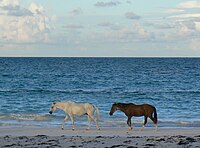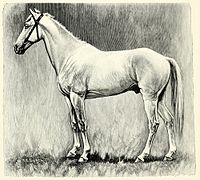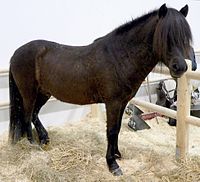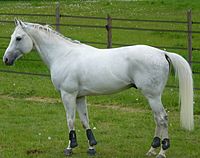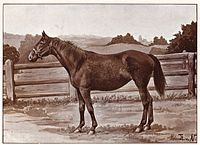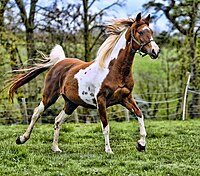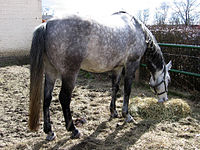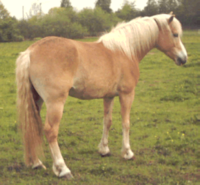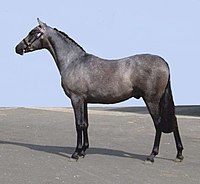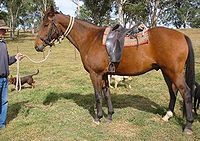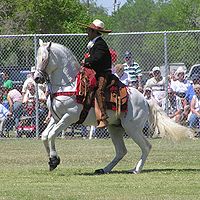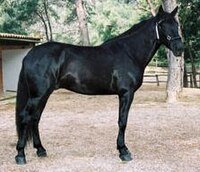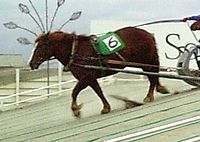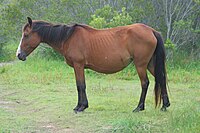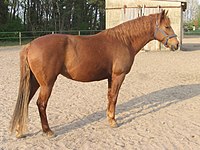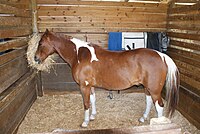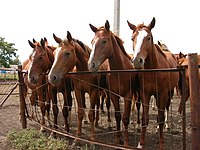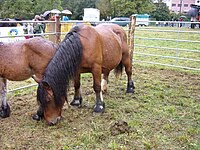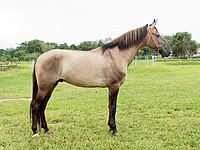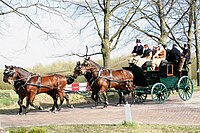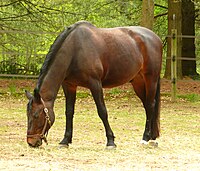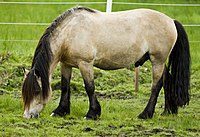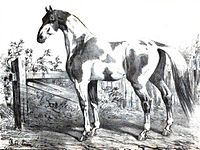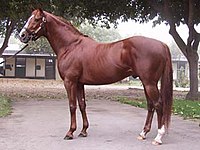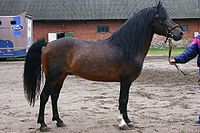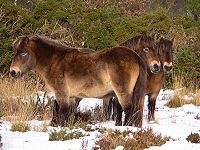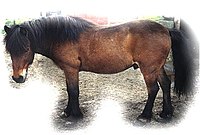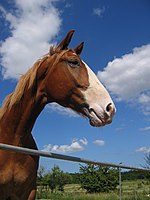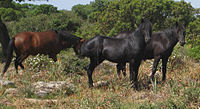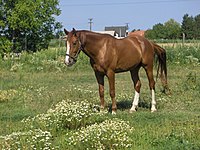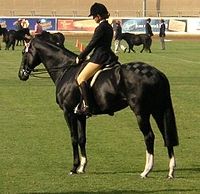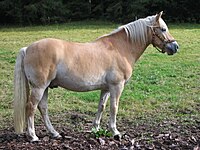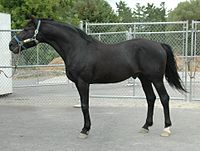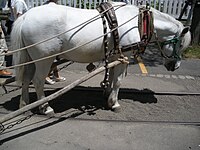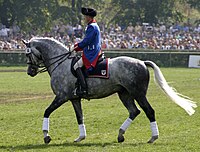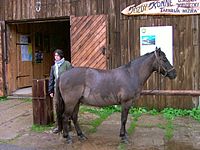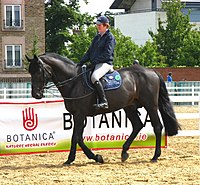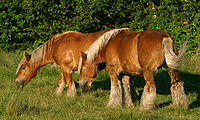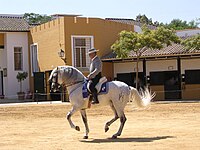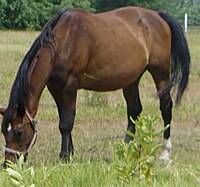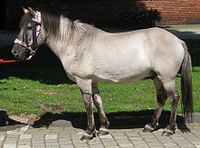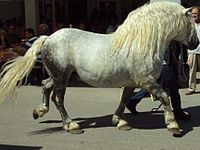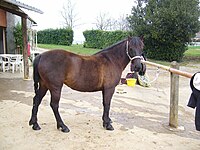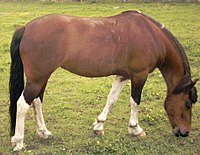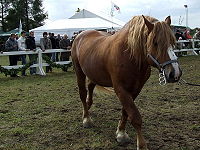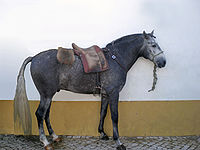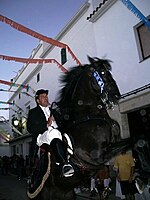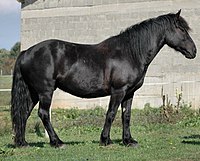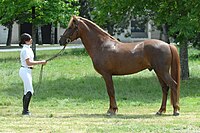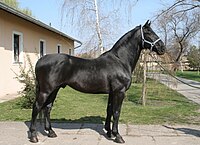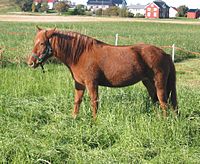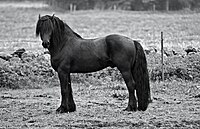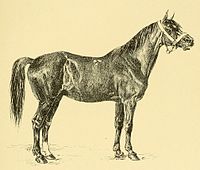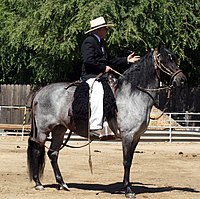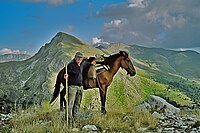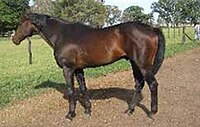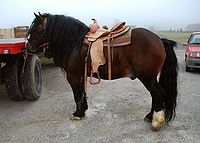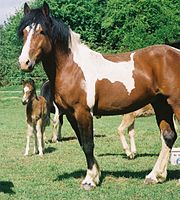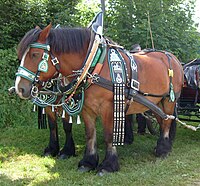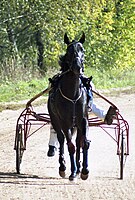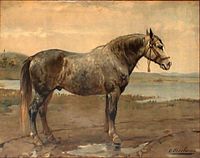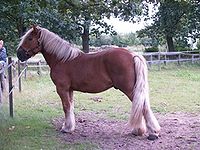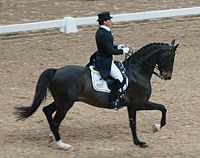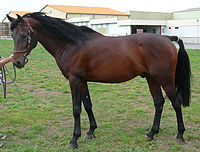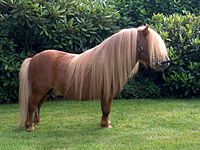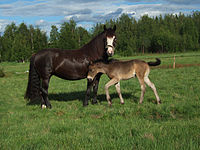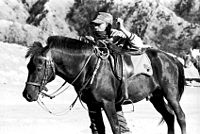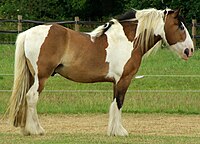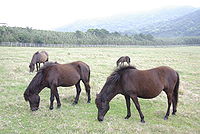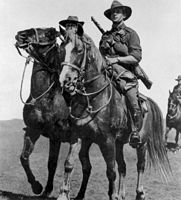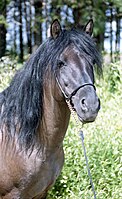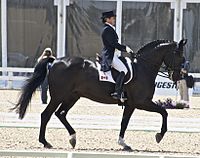List of horse breeds
The list of horse breeds is based on automatically extracted article components of the listed articles about breeds of domestic horses (Equus ferus caballus). The authors can be found in the version history of the respective article.
A.
| race | description | image | Brief information |
|---|---|---|---|
| Abaco wild horse | The Abaco wild horse is a breed of horse that lived in the Bahamas and the Dominican Republic. The population was exterminated except for three copies in the middle of the 20th century. The breed has been considered extinct since 2015. |
Origin : Bahamas , Dominican Republic |
|
| Abyssinian | The Abyssinian is a breed of small horses bred in Ethiopia. |
Origin : Ethiopia |
|
| Akhal-Teke | The Akhal-Teke horse (Turkmen Ahal-teke aty , Russian Ахалтекинская лошадь ; also Akhal-Teke horse ) is one of the oldest horse breeds in the world. Due to its isolation on desert oases and the arid desert climate geared towards extreme hardness, it is particularly suitable for difficult distance stretches. |
Origin : Turkmenistan |
|
| Aegidienberger | The Aegidienberger is a new breed of horse founded in 1981 by Walter Feldmann Senior and Walter Feldmann Junior, which emerged from a targeted crossing of Icelanders and Paso Peruano. |
Origin : Aegidienberg , 1981 |
|
| Ainos wild horse | |||
| Albanians | The Albanian , also known as the Mysekaya horse , is a small horse from Albania. |
Origin : Albania |
|
| Altai | The Altai horse (also Altai pony ) is a small, robust mountain pony . Due to its enormous load capacity (up to 160 kg) and the surefootedness in the mountains, it is a valued and indispensable load carrier in its home. |
Origin : Russia Breeding area : Altai Mountains between the rivers Volga and Ural |
|
| Old Real | The Altér-Real is a Portuguese horse breed that was founded by the Bragança dynasty. |
Origin : Portugal |
|
| American Bashkir Curly Horse | The American Bashkir Curly Horse - also short Curly Horse - is a North American horse breed. The curly top and long hair are characteristic, for which a dominant "curly gene" is responsible. |
Origin : USA, Nevada |
|
| American Cream Draft Horse | The American Cream Draft Horse is the only draft horse breed from the USA and is named for its cream-colored fur. |
Origin : USA |
|
| American Miniature Horse | American Miniature Horse (English " American Miniature Horse ") - also short Miniature Horse - is a horse breed from the USA. |
Origin : Europe |
|
| American Quarter Horse | The American Quarter Horse (also Quarter Horse ) is numerically the largest horse breed in the world with over 4.6 million registered horses. |
Origin : USA, 18th Century |
|
| American Saddlebred | The American Saddlebred , or American Saddle Horse , (formerly also known as the Kentucky Saddler ) is a gaited horse and the most famous show horse in the USA. Originally intended as a practical all-rounder, today it is mainly bred for shows, with great emphasis on the brilliance of the presentation. |
Origin : USA |
|
| American Shetland pony | The American Shetland pony or American Shetland pony is an American pony breed that goes back to the Shetland pony and is now divided into the groups Classic American Shetland and Modern American Shetland . |
Origin : USA |
|
| American Standardbred | The American Standardbred - also short Standardbred - or American Trotter is an American horse breed and is today the most important trotter breed worldwide in terms of performance. |
Origin : USA |
|
| American walking pony | The American Walking Pony is a relatively new breed that emerged from the crossing of the Tennessee Walking Horse and the Welsh Pony. It has two special gaits: the Pleasure Walk and the Merry Walk - both fast four-stroke gears. |
Origin : USA |
|
| American Warmblood | The American Warmblood is a horse of the warmblood type, which is mostly intended for the traditional sport horse disciplines dressage, show jumping, eventing and driving competitions. | ||
| Anadolu (Anatolian) | As Anadolu is known horse breeds that originate from areas of Anatolia in Turkey. Both the east and south-east Anadolu, as well as the central Anadolu emerged from the already extinct Anatolian horse. The Anadolu breed has been around for more than 1000 years. |
Origin : Turkey |
|
| Andalusians | All Iberian horse breeds bred in Spain with the exception of ponies and cold-blooded horses are commonly referred to as Andalusians , but in the narrower sense only the horses of the so-called "Pure Spanish Breed" ( Pura Raza Española , PRE for short). |
Origin : Spain |
|
| Anglo-Arabs | The Anglo-Arabian - also known as Malopolski in Poland - is a breed of horse that has been bred for about 150 years, especially in the south of France, Poland and England, and is a cross between English thoroughbred and Arabian breeds. |
Origin : France and Poland |
|
| Anglo-Normans | The Anglo-Normans , also known as Anglo-Normans , Cob Normand or (before 1830) as Normans or Normans , is a French horse breed that belongs to the warm-blooded animals. The original breeding area is Normandy in north-west France. |
Origin : Normandy |
|
| Appaloosa | Appaloosa is a breed of horse derived from the Spanish horse that was imported into North America in the 18th century. Their development is said to originate from the Nez Percé in North America. Appaloosas are recreational or sport horses that are particularly popular in the western sector. |
Origin : North America; Palouse -Prärie Idaho |
|
| Appaloosa Sport Horse | The Appaloosa Sport Horse is a relatively young breed of horse, a result of the increasing popularity of dressage and show jumping in US equestrian circles. By crossing warm-blooded animals, one would like to produce a sport horse in European format with the Appaloosa as the basis. Strictly speaking, the Appaloosa Sport Horse is nothing more than an Appaloosa of the sport horse type. |
Origin : USA |
|
| Ara appaloosa | |||
| Arabs | The term Arab does not designate the breed of Arabian horses, as is often found colloquially, but rather is a separate breed group within the same. Horses whose blood is not pure enough to be considered thoroughbred Arabs, but whose proportion of foreign blood is too low to be assigned to one of the three other breeds (Shagya Arabs, Anglo-Arabs or Arab half-blood) are classified into the Arabian breed group to become. |
Origin : not definable |
|
| Arab Berber | The Arab-Berber is a horse breed that was created around 1000 years ago by crossing Arabs or thoroughbred Arabs and Berbers. The Arab-Berber studbook is open, i.e. H. Even today, both pure and combination breeding is permitted. Both the Berber and the Arabian thoroughbred are permitted for combination breeding. |
Origin : Algeria , Morocco , Tunisia |
|
| Arabian pinto | The Arabian pinto (often also: Pintabian or Pintarab ) is contrary to many opinions not a color breed, but a specially recognized horse breed. The thoroughbred Arabs with piebald fur must have 99% Arabs in their blood. Although this breed is well known, it is one of the rare breeds with around 300 registered horses. In Germany, more than 90% Arabian thoroughbred is sufficient to be recognized as a Pintabian (ZSAA). |
Origin : USA |
|
| Arab half-breed | The Arab half-breed , also Partbred Arab or Arab Partbred , is a horse that must have at least 25% - the aim is at least 50% - Arab blood. The other breeds are not mandatory as long as the animals are registered in a stud book of a breeders' association recognized in the country of birth. However, cold blood breeds are excluded. The aim of breeding is a horse that has the typical breed characteristics of the thoroughbred Arabian, but is in a larger framework and is equipped with great hardness and endurance as well as a pleasant temperament. |
Breeding area : Predominantly Europe and North America |
|
| Arab Haflinger | From the Arabo-Haflinger cross between Arabs and Haflingers (mostly Arab stallions and Haflinger mare), which arose around 1960, the Arabian Haflinger breed arose in Austria . See also Edelbluthaflinger . |
Origin : Austria |
|
| Arabofriese | The Arabofriese is a sport horse breed bred based on the Friesian. The appearance can hardly be distinguished from the pure Frisian. The main breeding area is the Netherlands. |
Origin : Netherlands |
|
| Ardennes | The Ardennes is a very massive draft horse from the Ardennes that is primarily bred today as a slaughter horse, but also as a draft animal. |
Origin : Belgium , France |
|
| Arenberg-Nordkirchener pony | The Arenberg-Nordkirchener Pony was a pony breed from the Münsterland. |
Origin : Münsterland |
|
| Arravani | The Arravani is a gaited horse breed from the Greek Peloponnese. He is known for his tölt. |
Origin : Peloponnese |
|
| Assateague pony | The Assateague pony (also Chincoteague pony ) is a North American horse breed that is native to the Atlantic island of Assateague. There the ponies live in the wild, but are under human care. Some of the young horses are regularly sold, so there are now quite a few Chincoteague breeders in the United States. The Chincoteague Pony Breeders Association was founded in 2006. |
Origin : Assateague |
|
| Asturcon pony | The Asturcon pony (also called Asturians , Spanish Asturcón ) is an autochthonous breed of horse from the northern Spanish province of Asturias, which is kept semi-wild in the mountains of the Sierra de Sueve. There are also a number of stud farms that endeavor to preserve this breed. Outside the region, Asturcones are extremely rare. In 2008, around 1750 copies were registered by the Associatión de Criadores de Ponis de Raza Asturcón (ACPRA), of which around 1500 were in Asturias, plus a number of others in the neighboring provinces, and a small number spread across the rest of Spain. |
Origin : Spanish Atlantic coast |
|
| Australian Riding Pony | |||
| Australian Stock Horse | The Australian Stock Horse - also Stockhorse or Australian Stockhorse - is a breed of horse that is mainly bred as a utility horse by Australian cattle breeders for agricultural work. |
Origin : New South Wales |
|
| Australian warmblood | |||
| Australian pony | The Australian pony is a children's riding pony that originally comes from Australia. The breeding is monitored by the "Australian Pony Stud Book Society", a breeding association founded in 1929, which has fixed the breeding goal in detail. |
Origin : Australia |
|
| Auxois | The Auxois is a heavy cold blood horse breed from France. The breed is primarily used as a workhorse. |
Origin : France, 19th century |
|
| Aztec | The Aztec is a very young breed of utility horse that was created in Mexico to improve riding abilities. They have been bred there since the beginning of the 1970s, including at the Texoco stud in Mexico City. |
Origin : Mexico |
B.
| race | description | image | Brief information |
|---|---|---|---|
| Balearic | The Balearic Pony is an ancient, critically endangered Mediterranean breed from Spain. | ||
| Baluchi | The Baluchi is a breed of horse from Pakistan. The horses are persistent, nimble, frugal and are used as riding and draft horses. | ||
| Ban-ei | |||
| Banker Horse | |||
| Bardigiano | The Bardigiano is a mountain horse from the northern Apennines, which got its name from the town of Bardi in the upper Ceno valley. |
Origin : Northern Italy |
|
| Bashkire | The Bashkire - also Curly Bashkir , Bashkirskaya or Baschkirsky - is a resilient pony whose origins lie in the Russian steppe south of the Urals. |
Origin : Russia |
|
| Basuto pony | The Basuto pony is a South African horse breed that got its name from the cattle breeding tribe of the Basuto. |
Origin : South Africa |
|
| Batak pony | The Batak pony is an Indonesian pony breed from the island of Sumatra. |
Origin : Indonesia (North Sumatra) |
|
| Bavarian Warmblood | The Bavarian Warmblood is an old German horse breed whose breeding - similar to that of the Württemberg Warmblood - has been subject to an eventful history over the course of time. |
Origin : Rottal Bayern |
|
| Belgian warmblood | The Belgian Warmblood in Dutch Belgian Warmbloedpaard (BWP) is a young horse breed, with the creation of which both equestrian sport and warmblood breeding were established in Belgium. |
Origin : Belgium |
|
| Berber | The Berber is adjacent to the Arabian thoroughbred one of the oldest breeds of horses worldwide. |
Origin : Algeria, Morocco, Tunisia |
|
| Boer horse | |||
| Bosniak | The Bosniak (also Bosnian mountain horse ) is the typical, frugal mountain horse of the Dinarides. Bosniaks are distributed from Croatia, Bosnia, Montenegro and Serbia to Macedonia. Until the 1960s they were the most important agricultural workhorses in the mountain regions of the Western Balkans and have been exported to Western Europe in various ways. |
Origin : Bosnia |
|
| Boulonnais | Boulonnais is a cold-blooded horse breed with a pronounced oriental influence from the French region of Picardy. |
Origin : Picardie |
|
| Brabanters | The Brabant (also Belgian Draft , Flemings or Flemish horse is) a heavy horse race from the Belgian breeding area Brabant. |
Origin : Belgium |
|
| Brandenburger Warmblood | The Brandenburg Warmblood is a horse breed that, despite its long history, only emerged in its present form in the 1960s in the former German Democratic Republic. |
Origin : Brandenburg |
|
| Breton | The Breton is a breed of horse that originated in Brittany. It contains three types: the Trait Breton - a heavy draft horse, the somewhat smaller and lighter Petit Trait Breton, and the lighter postier . |
Origin : France |
|
| British Spotted Pony |
Origin : United Kingdom |
||
| Brumby | Brumby is an Australian wild horse, more precisely a breed of feral horse similar to the American mustang. They descend from domesticated horses and from riding horses that were released after the gold rush in the mid-19th century. The horses can reach a height of 135 to 150 cm in stick measure. Brumbies are considered to be persistent, agile, fast and wild. |
Origin : Australia |
|
| Budjonny | The Budjonny is a warm blood horse breed from Russia. |
Origin : Southern Russia |
|
| Burguete |
C.
| race | description | image | Brief information |
|---|---|---|---|
| Calabrian | The Calabreser (or Kalebreser ) is an Italian warmblood horse. |
Origin : Italy |
|
| Camargue horse | The Camargue horse is a small, robust domestic horse that is mainly bred in the Camargue - the Rhône delta in southern France. |
Origin : Rhone delta in southern France, beginning of the era |
|
| Camarillo White Horse | |||
| Campeiro | The Campeiro - literally translated field horse -, popularly also known as Marchador das Araucárias (untranslatable folklore with several simultaneous meanings), is a Brazilian horse breed that originated in the 16th century when Spanish and Portuguese horses settled on the plateau in Santa Catarina were. |
Origin : Brazil |
|
| Campolina | The Campolina is a Brazilian horse breed that owes its name to Cassiano Campolina , a farmer in Entre Rios de Minas, Minas Gerais state. |
Origin : Brazil |
|
| Canadian Horse | The Canadian Horse or Cheval Canadien is a Canadian breed of horse. |
Origin : Canada, 18th Century |
|
| Canadian Sport Horse | |||
| Canik | The Canik is a breed of horse from northern Turkey. It occurs mainly in the Black Sea region and is named after an earlier principality and the breeding area, the Canik Mountains. |
Origin : Turkey |
|
| Cheju pony | |||
| Cheval de Selle Français | The Cheval de Selle Français (German: French Riding Horse ) or Selle Français is the most important French sport horse breed. It is mainly used for jumping. The breed was composed in 1958 from horses of the riding horse type from all over France, with horses of Anglo-Norman descent having a substantial proportion. |
Origin : France |
|
| Chilean corralero | |||
| Chinese guoxia | The Chinese Guoxia ( Chinese 果 下馬 / 果 下马 , Pinyin guǒxià mǎ ) is a breed of south Chinese mini ponies that grow to be about one meter tall. |
Origin : China, Debao, Guizhou, Yunnan, Sichuan, Ningqiang |
|
| Cirit (horse) | The Cirit horse breed is a breed from Turkey. She is about 100 years old and comes from the Turkish Anadolu breed and Turkish-Arabian horses. They occur mainly in Eastern Anatolia. |
Origin : Turkey |
|
| Cleveland Bay | The Cleveland Bay is an English breed of horse whose origin dates back to the Middle Ages, but is often dated even earlier. It is often referred to as Old Cleveland Bay to better distinguish it from New Cleveland Bay - also known as the Yorkshire Coach Horse . |
Origin : England, medieval |
|
| Clydesdale | The Clydesdale is a powerful draft horse that originated in Scotland in the 18th century in the valley of the River Clyde. The breed became famous in the USA because the beer maker Anheuser-Busch shows it as a draft horse in commercials for the Budweiser brand and uses it as a mascot. Brewery tours in St. Louis and Fort Collins as well as in the Busch Gardens theme parks, which are also part of the group, include visits to the Clydesdale stables. |
Origin : Scotland, 18th century |
|
| Colorado Ranger | The Colorado Ranger (also Coloradobred ) is an American horse breed that usually has a tiger spotting. |
Origin : USA |
|
| Comtois | The Comtois is a horse breed that is mainly found in France and the Swiss Jura. |
Origin : France |
|
| Connemara pony | Connemara ponies are Irish riding ponies. Their home, the Connemara landscape, is located on the far west corner of Ireland. It is damp, barren and even today only sparsely populated. But for many centuries small horses have been living there half wild in the peaty swamps and scree slopes. These ponies have always been valued for their frugality, health and reliability. |
Origin : Ireland |
|
| Criollo | The Criollo is a horse breed that originated in Argentina, as well as a type of horse native to South America and the Caribbean, which has to be divided into different horse breeds through environmental re-breeding. There are horse breeds of the Criollo type with their own names in Argentina, Brazil, Chile, Peru, Cuba and Venezuela; the Criollo breeds found in Bolivia, Paraguay, Uruguay, Mexico and the Dominican Republic have no names of their own. |
Origin : South America, 16th century |
|
| Çukurova (horse) | The Çukurova is a Turkish horse. It is a cross between the Turkish Uzunyayla breed and a thoroughbred Arabian. However, it is not known how long ago this was. |
Origin : Turkey |
D.
| race | description | image | Brief information |
|---|---|---|---|
| Danish warmblood | The Danish Warmblood is a Danish warmblood horse breed that was specially bred for modern show jumping in the mid-20th century. |
Origin : Denmark, 20th century |
|
| Dales pony | The Dales pony is a small breed of horse from the east side of the Pennines in northern England. They have great stamina and were used as pack horses . |
Origin : eastern Pennines |
|
| Danubians | also: Donaupferd , Dunavska | ||
| Dartmoor pony | The Dartmoor pony is a small-stature pony breed native to the south-west of England. |
Origin : Southwest of England, 11th century |
|
| Davertnickel | The Davertnickel were a wild domestic horse breed that became extinct in the early 19th century. |
Origin : Germany |
|
| Delibos | The Delibos (also Deliboz ) is a horse breed of Azerbaijan. He is also known as the Delibos Azerbaijani, the Kazakh of Azerbeijan, or the Azerbaijan horse. |
Origin : Azerbaijan, 19th century |
|
| German classic pony | The German Classic Pony is a small thoroughbred horse descending from the Shetland pony . |
Origin : Germany |
|
| German Part-Bred Shetland Pony | The German Part-Bred Shetland Pony is descended from the Shetland pony and has been kept in its own stud book since 1999. |
Origin : Shetland Islands / Germany |
|
| German riding horse | The name German riding horse does not stand for its own breed of horse, but is rather a generic term for warmblood horses bred in Germany. Even if the individual warmblood breeds are crossed with one another on a large scale and some consolidation efforts can now be recognized within the breeding associations, warmblood breeding in Germany remains strongly regionally organized. |
Origin : Germany |
|
| German Riding Pony | The German Riding Pony is the most successful German pony breed. |
Origin : Germany, 20th century |
|
| German sport horse | The German Sport Horse is a warmblood horse breed that has been bred since 2003. It was created through the creation of a common breeding book of origin for their riding horse population of the horse breeding associations Berlin-Brandenburg, Saxony-Anhalt, Saxony and Thuringia. |
Origin : Brandenburg, Saxony, Saxony-Anhalt, Thuringia |
|
| Dillenburger Ramsnase | The horse breed known as Dillenburger Ramsnase is based on a breed based on Holstein and Danish mares with Spanish, Neapolitan and oriental stallions, which was initiated by the court stud of the Dillenburg counts as early as the 16th century.
The breed, which is now extinct, was a strong, yet beautiful middle stroke with dry and sinewy limbs and high action of the legs. As a special feature, the animals had a typical, slightly convex head shape. This eponymous Ramsnase was very much appreciated by baroque horses. The Dillenburger Ramsnasen were in demand as coach and parade horses. Extensive exports to the Netherlands took place particularly under William of Orange. |
||
| Chub horse | The Dölepferd - also Gudbrandsdal horse - is a Norwegian horse breed that is a small cold-blooded horse . His extraordinary performance in trotting races should be emphasized. |
Origin : Norway, 5th – 9th centuries Century |
|
| Dombes half-blood | The Dombes half-breed (French demi-sang de la Dombes , also known as cheval de Bresse or demi-sang de l'Ain ) is an extinct French horse breed from the historic regions of Dombes and Bresse in what is now the Ain department. |
Origin : France |
|
| Don horse | The Don horse is the traditional horse of the Don Cossacks, whose ancestors had lived in the Russian steppe for thousands of years. They also played a part in the expulsion of Napoleon's Great Army, which made them world famous. |
Origin : Russia, the Don |
|
| Dongolavi | |||
| Dülmen wild horse | The Dülmen wild horse is a breed of small horse that lives mainly in Dülmen in Westphalia in the Merfelder Bruch, a nature reserve of around 350 hectares. There are currently around 300 wild horses, more precisely wildlings of this breed , living in the wild horse track . The offspring of the approximately 50 mares and stallions living outside the area are not referred to as Dülmen wild horses , but as Dülmen horses . The horses, which are one of the oldest German horse breeds and were originally called Dülmener Brücher , have been on the GEH's Red List of Endangered Livestock Breeds since February 1994 and are classified in hazard category I, i.e. as extremely endangered. |
Origin : Germany |
E.
| race | description | image | Brief information |
|---|---|---|---|
| Noble Haflinger | The Edelbluthaflinger was created in the 1960s from Haflingers , which were refined by increasing the proportion of Arabian blood in order to obtain a modern, versatile, sporty small horse. Since 2006, a stud book and a stud book for Edelbluthaflinger have been kept in the FN's breeding association regulations . The criterion for entry in the stud books is a proportion of Arab blood between 1.57% and 25%, with the proportion being traced back six generations. |
Origin : Germany |
|
| Noble warmblood | The noble warmblood , also known as the noble warmblood of the GDR due to its breeding area , was a German horse breed. It united the riding horse breeds of the German Democratic Republic (GDR) from 1971 to 1990. |
Origin : different races of the GDR |
|
| Emscherbruch | The Emscherbrücher or Emscherbrücher Dickkopp was a wild domestic horse breed. Its occurrence was first mentioned in a document in 1396. It was widespread in the rift along the Emscher between Waltrop and Bottrop until the beginning of the 19th century. The last Emscherbrücher were captured in the 1840s and sold to Duke Alfred von Croÿ in Dülmen. |
Origin : Germany |
|
| English blood | The English thoroughbred refers to a horse breed from the group of thoroughbred horses that has been specially bred for horse racing . In pedigree papers, English thoroughbreds are indicated by an xx after the name to easily distinguish them from other horse breeds . |
Origin : United Kingdom |
|
| Eriskay pony | |||
| Estonian nag | The Estonian Klepper (Estonian Eesti Hobune ; also Estonian Pony ) is a very old horse breed from Estonia. The breed has retained the characteristics of the domestic horse of the Klepper type, which was previously widespread throughout the Baltic Sea region. It also formed the basis for other Estonian horse breeds such as the Torgel horse. |
Origin : Estonia |
|
| European Appaloosa pony | The European Appaloosa pony is a breed of horse whose breeding is operated by the ECHA-ESV. The breeding goal is a size of up to 142 cm and the following colors: tiger piebald, black tiger, snowflake, few spot and roan / marble piebald. |
Origin : |
|
| Exmoor pony | The Exmoor pony is a medium-sized English pony breed. It is the most pristine of the British ponies, some herds still roam freely in the moors of South West England (e.g. Exmoor, a wild animal stud farm). A number of unique characteristics have been noted in their ancestors. |
Origin : Exmoor |
F.
| race | description | image | Brief information |
|---|---|---|---|
| Faroe pony | The Faroe pony (Faroese: føroysk ross ) is a separate breed of horse that differs from the Icelandic horse and fjord horse, which are now in the majority in the Faroe Islands. |
Origin : Faroe Islands |
|
| Falabella | The Falabella is an Argentine miniature horse breed. |
Origin : Buenos Aires |
|
| Fur pony | The Fell Pony is a robust breed of small horse from the Fell Mountains in Northern England. The name Fell-Pony indicates on the one hand the possible area of origin, a range of hills in the county of Cumbria west of the Pennines, called Fells, and on the other hand the size of the horse. Traditionally, all horse breeds under a height of 148.5 cm are called ponies. |
Origin : England, approx. 100 AD. |
|
| Finn horse | The Finnhorse ( Finnish Universal ) is a Finnish all-round horse and the only original horse breed in Finland. The Finnhorse is divided into four types: a heavy, cold-blooded draft horse (Työhevonen), a light draft horse (Juoksija), a versatile riding horse (Ratsuhevonen) and a small horse (Pienhevonen). |
Origin : Finland |
|
| Frederiksborger | The Frederiksborger - also Fredriksborger - is an old Danish horse breed that has developed from a once coveted type to an endangered breed due to incorrect breeding activities. |
Origin : Denmark |
|
| Freiberger | The Freiberger is the only originally Swiss horse breed and today the last representative of the light draft horse in Europe. |
Origin : Franches-Montagnes (Jura), 15th century |
|
| Friezes | The Friesian is a Dutch breed of horse that was originally bred in the province of Friesland. |
Origin : West Friesland |
|
| Furioso North Star | Furioso-North Star (short Furioso ) is a horse breed from Hungary. Furioso belongs to the Hungarian half-bloods. In Bavaria, these horses are also bred in Leutstetten. These horses are known as the special breed Leutstettener. |
Origin : Hungary |
G
| race | description | image | Brief information |
|---|---|---|---|
| Galiceno pony | The Mexican Galiceno pony is well suited as a workhorse under the saddle, but it is also a popular riding horse for young people and continues to be driven. |
Origin : Galicia |
|
| Galloway | |||
| Garrano | |||
| Gelderland | The Gelderlander is a Dutch horse breed that is mainly used as a carriage horse. |
Origin : Netherlands, 19th century |
|
| Genete also Jenet, Jennet, Genette, Genet |
Origin : Spain, Middle Ages. |
||
| Giara horse | The Giara horse is also called the Sardinian pony or Achetta pony . It comes from Italy. There it lives semi-wild in small family groups. |
Origin : Italy |
|
| Gidran | The Gidran is a horse breed from Hungary. |
Origin : Hungary |
|
| Gotland pony | The Gotland pony (Swedish Gotlandsruss ) is an old Swedish breed of small horses on the island of Gotland and surrounding islands. |
Origin : Sweden |
|
| Groninger | The Groninger is a Dutch horse breed, which is an important breeding basis for the Dutch Warmblood, which is very successful in equestrian sports. Along with the Gelderlander, it influenced many Dutch breeds. It can hardly be found in its original form of a robust work and agricultural horse. It is used more as a coarse-bodied carriage horse these days. |
Origin : Groningen |
H
| race | description | image | Brief information |
|---|---|---|---|
| Hack | A hack is an elegant type of competition horse. Most of the hacks are actually thoroughbreds or crossbreeds between thoroughbreds and Anglo-Arabs, so they are mostly hot-blooded. They are generally 147 to 160 cm tall and can have any coat color. |
Origin : Great Britain |
|
| Hackney | The Hackney (Norman haquenée for Zelter or passanger) is a trotter bred primarily as a representative carriage horse and not as a workhorse. |
Origin : England |
|
| Haflinger | The Haflinger is an old, down-to-earth breed from Italy, which takes its name from the village of Avelengo near Merano in what is now South Tyrol. But they are not only good riding ponies, which can sometimes take more weight, but also useful carriage ponies. In addition to the Federal Republic of Germany, Austria and Switzerland, Haflingers are bred in almost all of Europe and in over 70 countries worldwide. |
Origin : South Tyrol |
|
| Hanoverian | The Hanoverian is numerically the strongest European warmblood breed. In the past few decades, the Hanoverian breeding association was one of the most successful breeding horses in the disciplines of jumping and dressage thanks to the sporting successes of its representatives registered and analyzed by the World Breeding Association for Sport Horses (WBFSH). |
Origin : Germany, 15th century |
|
| Hessian Warmblood | The Hessian Warmblood is a warmblood horse breed bred until 2009, which from then on has been fully incorporated into the Hanoverian Horse Breeding Association. |
Origin : Hessen, mid-19th century |
|
| Rear horse | The Heckpferd is a cross between different European pony and horse breeds . The brothers Heinz and Lutz Heck tried to breed a horse that, in their imagination, resembles the extinct Tarpan wild horse. |
Origin : Germany, 20th century Breeding area : Germany Distribution : Central Europe Height : 40 cm Colors : mostly light-colored mouse falcons, rarely with zebra stripes on the legs. Area of application : zoos, extensive agriculture |
|
| Highland pony | The Highland Pony is native to the rugged landscape of Scotland. |
Origin : Scotland |
|
| Hinis (horse) | The Hinis horse breed is a breed from Turkey. She is about 100 years old and comes from the Turkish Anadolu breed and Turkish-Arabian horses. It occurs mainly in Eastern Anatolia. They are named after the province of the same name in Erzurum. |
Origin : Turkey |
|
| Hispanic Arabs | The Hispano-Arab is a warmblood horse breed that is bred from the Andalusian (more precisely: Pura Raza Española, PRE) by crossing with Arabian thoroughbred. |
Origin : Spain |
|
| Hokkaido pony | The Hokkaido pony (Japanese. 北海道 和 種 , Hokkaidō washu ), as a nickname also Dosanko ( 道 産 d, German about: "Child born in Hokkaidō"), is next to the Kiso, Noma, Taishu, Misaki-, Tokara -, Miyako and Yonaguni pony one of the eight native Japanese horse breeds still in existence. |
Origin : Japan |
|
| Holsteiner | The Holsteiner is a German horse breed. |
Origin : Germany |
|
| Hutsul | The Huzule (also Old Austrian Huzule ) is a pony breed and comes from the "Huzulei", an area in the Eastern Carpathians north of the river Bistritz, where the descendants of the Tatars and Cossacks, also called Hutsuls, settled as mountain farmers. |
Origin : Hutsuls |
I.
| race | description | image | Brief information |
|---|---|---|---|
| Indian half-breed | The Indian half-breed is a breed of horse that emerged from the Indian Kathiawari and the Australian whale by crossing. |
Origin : India |
|
| Iomud | The Iomud (also Jomud , Jamud , Iomudskaya (Russian), Yamud (Iran)) is a Turkmen breed of horse. |
Origin : Tashauz oasis in southern Turkmenistan |
|
| Irish sport horse | The Irish Sport Horse (English. Irish Sport Horse ) is a breed of horse from Ireland, which was created by crossing the Irish Draft with thouroughbred. This is a relatively new targeted breed, the aim of which is a sport horse that is primarily equipped with a jumping ability. The mating of draft mares with thoroughbred stallions themselves has always been carried out in Ireland in order to obtain a horse suitable for hunting - the Irish Hunter . |
Origin : Ireland |
|
| Irish Draft Horse | The Irish Draft Horse or Irish draft horse is the classic Irish horse breed. It is a strong, rather stocky workhorse. The breed is believed to have originated from Connemara ponies, Spanish horses, and Old English warmbloods. |
Origin : Ireland |
|
| Icelandic horse | The Icelandic horse , also called Icelander or (incorrectly) Icelandic pony , is a versatile and robust breed of horse originating from Iceland, which, thanks to its strong physique, can also be ridden by adults. Icelandic horses belong to the group of gaited horses, as most of them not only have the basic gaits of walk, trot and gallop, but also the genetically fixed gaits of tölt and / or pass. Only pure-bred animals whose ancestors were born in Iceland without a gap are recognized as "Icelandic horses". The import of horses is prohibited in Iceland. The fur of the Icelandic horse can show a lot of colors, only there is no tiger piebald in the Icelanders. |
Origin : Iceland |
|
| Italian cold blood | The Italian draft horse is a rare breed of horse that can be found almost exclusively and only in small numbers in Italy. |
Origin : Italy |
J
| race | description | image | Brief information |
|---|---|---|---|
| Yakut horse | The Yakut horse is adapted to the extremely cold climate of Sacha (Eastern Siberia), survives free-range temperatures that can drop to -70 ° C and is able to track down and dig up food under a high blanket of snow. |
Origin : Sacha (Yakutia) |
|
| Java pony | The Java pony is a breed of small horses descending from the Mongolian wild horse and native to the island of Java. |
Origin : Indonesia |
|
| Jutlander | The Jutlander is a Danish draft horse breed that has been bred for centuries with different goals. Due to their fox color with light long hair and hangings, their representatives look very similar to the heavy Haflinger type. |
Origin : Northern European lowlands |
K
| race | description | image | Brief information |
|---|---|---|---|
| Cabardines | The Kabardiner is a mountain horse from the Caucasus, which is still in great need there by the rural population and which today finds many friends in Western Europe among recreational, hiking and, above all, endurance riders. It takes its name from the Kabardine people, a Circassian tribe. |
Origin : North Caucasus, 16th century |
|
| Karabagh | The Karabagh (Azerbaijani Qarabağ atı ) is a Caucasian breed of horse. |
Origin : Karabagh |
|
| Karabeans | The Karabaier is a breed of horse from Uzbekistan. |
Origin : Uzbekistan and northern Tajikistan |
|
| Karacabeyer | The Karacabeyer is a breed of horse from Turkey. |
Origin : Turkey |
|
| Karachai | |||
| Carthusian horse | The Carthusian (span. Cartujano ) belongs as a sub-race of the Andalusian to the so-called pure Spanish breed (PRE). |
Origin : Spain |
|
| Small Caspian horse | The Caspian Small Horse is a horse breed whose region of origin is the coast of the Caspian Sea. It is the size of a pony, but the physique is that of a horse, so it is a so-called miniature horse. |
Origin : Caspian Sea |
|
| Kathiawari | The Kathiawari is a pony breed from the Indian island of Kathiawar, which looks more like a thoroughbred than a pony. |
Origin : Kathiawar, 14th century |
|
| Kazakh | As Kazakh refers to a group of horse breeds from the Asian steppe. The most important variants of the breed are the Aedav, a type of riding horse and the Jabe, which is bred for meat and milk production. |
Origin : Kazakhstan |
|
| Kentucky Mountain Saddle Horse | The Kentucky Mountain Saddle Horse (KMSH) is a close relative of the Rocky Mountain Horse and is one of the North American gaited horse breeds. The country of origin of the Kentucky Mountain Saddle Horse is Kentucky and the nearby Appalachian region in the USA. |
Origin : Kentucky and Appalachian Mountains |
|
| Kinsky horse | The Kinsky horse (also Equus Kinsky , Chlumetzer and Böhmischer Hunter ) is a horse of the type of a light warmblood horse, which was bred in its country of origin Bohemia in today's Czech Republic until the middle of the 20th century and was represented there as the predominant breed. |
Origin : Bohemia |
|
| Kisbéri | also: Kisbéri félvér , Kisbérer half-blood | ||
| Kiso pony | Japanese: 木 曽 馬 | ||
| Kladruber | The Kladruber is a Czech horse breed, originally from the national stud in Kladruby nad Labem (on the Elbe), an Austro-Hungarian stud establishment comparable to that in Lipica. It was originally bred as a carriage horse, but is now increasingly used for riding purposes. |
Origin : Czech Republic |
|
| Small German riding horse | Small German Riding Horse is the name of a horse breed bred in Germany. | ||
| Knabstrupper | The Knabstrupper is a horse breed from Denmark. They are mostly conspicuously drawn tiger piebalds. |
Origin : Denmark |
|
| Konik | The Konik (from Polish: horses , small horse ) is a Ponyrasse from Central and Eastern Europe. The ponies are very robust and are used both in agriculture and in the conservation of nature reserves, for example in the Oostvaardersplassen, in the German nature reserves Geltinger Birk (Baltic Sea) and Wöhrdener Loch (Speichererkoog, Dithmarschen), and in the Polish Białowieża National Park, where they live wild. |
Origin : Poland |
|
| Corsican pony | The Corsican pony (Corsican cavallu corsu or paganacce ) is a small riding horse native to Corsica. |
Origin : Corsica |
|
| Croatian cold blood | The Croatian draft horse ( Hrvatski Hladnokrvnjak ) is an autochthonous Croatian draft horse breed. |
Origin : Croatia |
|
| Kushum | The Kushum (other names: Kushumskaya (Russian), West Kazakh Saddle-Draft (English)) is a new breed of horse from Kazakhstan that was bred between 1931 and 1976. |
Height : 150–160 cm. |
|
| Kustanai | The modern Kustanai is a massive horse from western Kazakhstan that combines the advantages of a riding horse with the robustness of a steppe horse. It is named after the Kustanai stud, which in turn is named after the city of Kustanai. |
Origin : Kazakhstan |
|
| KWPN | The KWPN (Koninklijk Warmbloed Paard Nederland) or Dutch Warmblood is a young breed of horse that emerged from the cross between Gelderlanders and Groningers. |
Origin : Netherlands |
L.
| race | description | image | Brief information |
|---|---|---|---|
| Landais pony | The Landais pony is a French breed of horse. The ponies are named after their place of origin, the French province of Landes. There they lived semi-wild in the forests of the Les Landes region on the Bay of Biscay. |
Origin : Landes an der Biscaya |
|
| Lehmkuhlener pony | The Lehmkuhlener pony is a rare pony breed from Schleswig-Holstein. It comes from the Lehmkuhlen estate near Preetz in Schleswig-Holstein and was initially established as a private breed by Agnes Baroness von Donner in the first quarter of the 20th century. Later it was listed in the herdbook of the German Small Horse Studbook at the Association of Small Horse Breeders Germany eV. With a population of 13 animals in 2000, including 8 stallions and 5 mares, it is listed in Category I (extremely endangered) in the Red List of the Society for the Conservation of Old and Endangered Domestic Breeds . |
Origin : Plön district, Gut Lehmkuhlen |
|
| Latvian cold blood | The Latvian draft horse (Latvian Latvijas ardenis , Latvian Ardennes) is a medium-weight draft horse of the Swedish Ardennes type. Today this breed has almost disappeared. |
Origin : Latvia |
|
| Latvian Warmblood | The Latvian Warmblood is a breed of horse from Latvia. |
Origin : Latvia |
|
| Leutstettener | The Leutstetten horse (also known as the Sárvár horse ) is a rather rare horse breed (approx. 50 specimens) that was bred in the Leutstetten stud in Bavaria until 2006. Breeding is now in the hands of a few private breeders. In terms of type, the Leutstetten horse is a noble half-breed. |
Origin : Sarvar |
|
| Lewitzer | The Lewitzer is a pony breed from Mecklenburg-Western Pomerania. |
Origin : Mecklenburg-Vorpommern |
|
| Liebenthal horse | The Liebenthaler horse (also known as Liebenthaler Wildpferd , Liebenthaler Wildling or simply Liebenthaler ) was created in 1960 as a forest tarpan re-breeding project from a cross between Fjord horses and Koniks. |
Origin : Bavaria, Brandenburg |
|
| Lipizzaner | The Lipizzaner , (Slovenian: Lipicanec ), this name appears for the first time in 1786, is the oldest cultivated horse breed in the world. The Karster , as it was called earlier, is closely associated with the Habsburg family. This breed got its name from the Lipica Stud, the original breeding facility in the former Habsburg monarchy. |
Origin : Lipica, at inception Inner Austria, today Slovenia |
|
| Lithuanian cold blood | The Lithuanian draft horse , also known as the Lithuanian heavy draft horse , is a cold blood horse breed from Lithuania, which was bred on the basis of the indigenous landrace Žemaituka. The Lithuanian draft horse is bred in almost all parts of Lithuania. |
Origin : Lithuania |
|
| Locals | The Lokaier is a horse breed of oriental descent from Tajikistan. |
Origin : Tajikistan |
|
| Losino | |||
| Lusitano | The Lusitano is a Portuguese horse breed that is of the Baroque type. |
Origin : Portugal |
M.
| race | description | image | Brief information |
|---|---|---|---|
| Malakan (Ardahan) | The Malakan is a Turkish horse breed from Eastern Anatolia. It is the only cold blood breed in Turkey. |
Origin : Turkey |
|
| Mangalarga Marchador | The Mangalarga Marchador (also Mangalarga Mineiro ) is a Brazilian horse breed that originated in the state of Minas Gerais and should not be confused with the Mangalarga (also Mangalarga Paulista ) horse breed, which originated in the state of São Paulo . |
Origin : Brazil |
|
| Mangalarga Paulista | The Mangalarga or Mangalarga Paulista is a Brazilian horse breed that was created in the state of São Paulo during the first three decades of the 20th century by crossing horses of the Mangalarga Marchador breed with horses of breeds of Anglo-Saxon origin such as Morgan, American Saddlebred and Hackney. Mangalarga Paulista and Mangalarga Marchador have different breeding regulations, breeding goals and breeders associations and should therefore not be confused with one another. |
Origin : Brazil |
|
| Maremmano | The Maremmano is a horse from the Maremma in southern Tuscany, which was previously used as a carriage and shepherd horse, but has been further developed in recent years with a view to riding horses. |
Origin : Maremma |
|
| Marwari | The Marwari is a very sturdy Indian breed of horses known for their sickle ears. |
Origin : Northwest India |
|
| Mecklenburg warmblood | The Mecklenburg is a German horse breed. |
Origin : Germany |
|
| Međimurec | The Međimurec ( Međimurje horse outdated, Murinsulaner ) is an autochthonous Croatian draft horse - horse breed originating from the Međimurje County . |
Origin : Croatia |
|
| Menorcans | The Menorquiner (cat. Menorquí , Spanish. Menorquín ), officially known as the pure-bred Menorcan horse ( Caballo de Pura Raza Menorquina , PRM for short ), is an Iberian horse breed originating from the Spanish island of Menorca. |
Origin : Menorca |
|
| Mérens | The Mérens is a medium-sized, stocky mountain horse (also known as the Ariègeois horse ) from France. It is similar to the fur pony and the Dales pony. |
Origin : France |
|
| Messara horse | The Messara horse (also called Cretan horse ) is a breed of horse that is native to the Greek island of Crete. The main distribution area is in the province of Heraklion, which is also where the Messara Plain is located, which explains the name of the breed. |
Origin : Crete |
|
| Mini Shetland Pony | The mini Shetland pony is a breed form of the Shetland pony and has its origin in England. |
Origin : England |
|
| Misaki pony | also: Miysaki pony , Japanese: 御 崎 馬 | ||
| Missouri Fox Trotter | The Missouri Fox Trotter was bred in the Ozark Plateau area in the American states of Arkansas and Missouri in the 1820s and is one of the oldest American horse breeds. |
Origin : Missouri |
|
| Miyako pony | The Miyako pony (Japanese 宮 古 馬 , Miyako-uma ) is a pony breed from Miyako Island, which is part of Okinawa Prefecture in Japan. Along with the Hokkaido, Kiso, Noma, Taishu, Misaki, Tokara and Yonaguni pony, it is one of 8 endemic horse breeds still in existence in Japan. |
Origin : Miyako |
|
| Mongolian horse | The Mongolian horse ( Mongolian Морь , Morj ; [mœɾ] ) is the declared favorite animal of the Mongols, and not just since Genghis Khan conquered half the world with their help. The traditionally living nomads keep over 3 million animals, so there are significantly more horses in the country than human inhabitants. Despite their small size, the Mongols do not like to hear their horses called "ponies". |
Origin : Mongolia |
|
| Morab | |||
| Morgan | The Morgan is an American horse breed that goes back to the stallion Figure . |
Origin : USA, 19th century |
|
| Murgese | The Murgese is an Italian horse breed that has to be classified as a type between warm blood and cold blood. |
Origin : Apulia |
|
| mustang | Mustang is the name of the wild horses of America. They have been known since the 16th century. |
Origin : North America |
N
| race | description | image | Brief information |
|---|---|---|---|
| Namibian wild horse | The Namibian wild horses (also known as Namib horses for short ) or simply desert horses or, rarely, also Namibs live on the edge of the Namib in the southwest of Namibia and can be observed at Garub about 20 km west of Aus. |
Origin : Europe / Namibia |
|
| Nangchen |
Origin : Tibet |
||
| Narragansett Pacer | extinct breed |
Origin : New England |
|
| Neapolitans | The Neapolitan was a horse breed bred in the Kingdom of Naples, which was considered the best for dressage purposes in the Baroque and which helped to shape the breeding of Baroque horses throughout Europe. Two of the six main lines of the Lipizzaner can be traced back to Neapolitans (Conversano and Nepolitano). |
Origin : Naples |
|
| Nederlands Mini Paarden | |||
| New Forest pony | The New Forest pony is an easy-going riding pony from southern England. |
Origin : England |
|
| Dutch cold blood | The Dutch draft horse (Nederlands Trekpaard) is a Dutch breed of horse that was originally bred as a workhorse specializing in tensile loads. It was mainly used on heavy soils in agriculture but also in industry. Today the trek couple is mainly used in the leisure sector and as a tourist attraction. The horse is also used in traditional ring rides in Zeeland, where it is decorated and ridden without a saddle. |
Origin : Netherlands |
|
| Noma pony | Japanese: 野 間 馬 | ||
| Vernier | The Nonius is the oldest Hungarian warmblood horse breed that does not go back to the native Hungarian landrace. It was founded in 1816 by the Anglo-Normans stallion Nonius in the Hungarian stud Mezöhegyes . |
Origin : Hungary, 19th century |
|
| Nooitgedacht pony | |||
| Nordland lyng horse | also: Nordland horse , Nordlandshest , Lofoten pony | ||
| Northern Swedish draft horse | The northern Swedish draft horse is a very hard-working little draft horse. The neck is short and thick. The mane is very thick and coarse. The head looks square. The shoulders are sloping, so the horse has a good ability to gallop. The horse is about 160 cm tall and can be found in all basic colors. |
Origin : Sweden |
|
| Norfolk Trotter |
Origin : England |
||
| Noriker | The Noriker is a medium-weight, strong and persistent mountain cold blood horse . The breeding area includes the mountain ranges of the Austrian and German Alps. The Southern German Cold Blood is a cold blood breed that emerged from the Noriker horse and into which other breeds were crossed from the Second World War. A smaller type of Noriker was the Abtenauer , which was bred in Abtenau, but has meanwhile been incorporated into the modern Noriker population in Austria. |
Origin : Austria |
|
| Norwegian fjord horse | The Norwegian fjord horse (also Norwegian , fjord horse or fjord pony ) is a horse breed that originates from the coastal areas of Norway. |
Origin : Norway |
O
| race | description | image | Brief information |
|---|---|---|---|
| Oil horse | The Öland horse , also known as the Ölännigen , was a horse breed on the Swedish island of Öland in the Baltic Sea. The breed died out in the early 20th century. There are efforts to breed new. |
Origin : Öland |
|
| Austrian warmblood | The Austrian Warmblood is a warm-blooded horse breed that goes back to the Old Austrian Warmblood . |
Origin : Austria |
|
| Oldenburg | The Oldenburger is a German riding horse breed. It is named after the main breeding area Oldenburg in Northern Germany with one of the largest German horse breeding associations. There has been evidence that the so-called "Old Oldenburgs" have been bred here since the early 17th century. Today the Oldenburg is a well-known type of sport horse with great international success. |
Origin : Germany, 17th century |
|
| Orlov-Rostopchiner | |||
| Orlov trotter | The Orlov trotter is a breed of horse from Russia. Its breeding began at the end of the 18th century. |
Origin : Chrenowoje near Bobrov, today Voronezh Oblast |
|
| East Frisians / Old Oldenburg | Horses of formerly independent breeds for which a joint stud book has existed since the late 1980s are referred to as old Oldenburg and East Frisians . The horse breed is now known under the common name Ostfriese / Alt-Oldenburger . |
Origin : East Friesland |
P
| race | description | image | Brief information | |
|---|---|---|---|---|
| Paint Horse | The Paint Horse is a piebald horse breed that originated in the American Quarter Horse. His monochrome offspring were formerly known as Breeding Stock , today as Solid Paint Bred Horse . In the 1960s, the American Paint Horse Association was founded. |
Origin : USA, 18th Century |
||
| Panjepferd | The Panje horse (from panje = Russian or Polish farmer) was used in agriculture in Eastern Europe and was known for its toughness and undemanding nature. Perhaps the conical shape can be seen as an ancestral form, but Panjepferde rather emerged from haphazard crossings. The "Panjepferd" is more the agricultural horse of Eastern Europe than a breed name. |
Origin : Eastern Europe (Poland), Russia, Ukraine |
||
| Pantaneiro | ||||
| Paso Fino | Paso Fino is a South American gaited horse breed. Paso Fino means translated: “fine walk”. A horse gait is named after them. |
Origin : Colombia, Puerto Rico, Hispaniola |
||
| Paso Iberoamericano | The Paso Iberoamericano is to gaited horses counting horse breed from Costa Rica . |
Origin : Costa Rica |
||
| Paso Peruano | The Paso Peruano or Caballo de Paso is a horse breed from South America. |
Origin : Peru |
||
| Peneia pony | The Peneia pony is a breed of horse originating from the Greek province of Eleia. |
Origin : Greece |
||
| Percheron | The Percheron is a cold-blooded horse breed from the Le Perche region in Normandy. |
Origin : Le Perche, France |
||
| Palatinate-Ardennes | The Palatinate-Ardennes is a comparatively young horse breed that originated around 1900. The breeding basis is characterized by breeding animals of the French draft horses, such as Lorraine, Comtois and Ardennes in particular, as well as Belgians, Rhenish German draft horses and Bavarian draft horses. |
Breeding area : Rhineland-Palatinate-Saar |
||
| Pindos pony | The Pindos pony (Greek: αλογάκι της Πίνδου) is a pony breed from the Pindos Mountains near Thessaly and Epirus in Greece. |
Origin : Greece |
||
| Poitevin | The Poitevin , also called le Cheval Moulassier Poitevin or simply Moulassier , is a cold-blooded horse breed. |
Origin : Poitou |
||
| Polo Argentino | The Polo Argentino ( Argentine polo pony ) is a breed of horse from Argentina. |
Origin : Argentina |
||
| Pony of the Americas | The Pony of the Americas is a horse breed that originated in the USA in 1954. |
Origin : USA, 1954 |
||
| Posavina horse | The Posavina horse (also Croatian Posavac ; Croatian hrvatski posavac [ ˈpɔːsaʋats ], "posavski konj" or "posavski bušak" ) is a breed of horse from Croatia that is counted among the cold-blooded horses. As the name of the Posavina horse suggests, the breed comes from the Croatian area around the Sava River in Slavonia, also called Posavina. In the immediate vicinity is the Turopolje region, which is why the breed of horse is often referred to as the Turopolje horse. |
Origin : Croatia |
||
| Pottok pony | The Pottok pony [ 'pocok ] is an old, rare pony breed from the Basque Country. Pottok , with a certain article also Pottoka , means “little horse” in the Basque language. The animals still live semi-wild in the western Pyrenees, both in France and in Spain. In Spain they are also known under the name Poni Vasco Navarro , as they are kept in the autonomous regions of the Basque Country and Navarre. |
Origin : Basque Country |
||
| Przewalski horse | The Przewalski horse is also known under the name Takhi, Asian wild horse or Mongolian wild horse and is an endangered Mongolian wild horse which has long been thought to be the last living wild horse breed. In the meantime, the horse breed became extinct in the wild, but around 2,000 specimens are now living in Mongolia again . |
Origin : entire Eurasian steppe
Breeding area : only a few large landowners in Europe and Asia Height : 120-146 cm Colors : light brown to slightly reddish with a dark mane and tail |
||
| Pura Raza Española | The Pura Raza Española (in German Pure Spanish Race , abbreviated PRE or PRE) is a horse breed that originated in Spain and has been strictly regulated since 1912. The horses belong to the Spanish pedigree horses known for a long time under the somewhat vague generic term Andalusians. The breed is also known as the Iberian horse and is mainly bred in the Extremadura and Andalusia regions. PRE horses have a proven parentage (stud book and licensing). |
Origin : Spain |
Q
| race | description | image | Brief information |
|---|---|---|---|
| Quarab | The Quarab Horse is a cross between the Arabian thoroughbred and the American breeds Paint Horse or Quarter Horse. |
Origin : USA, 1950s |
|
| Quarter pony | Pony version of the quarter horse | ||
| Quba | Quba is a breed of horses from Azerbaijan. |
Origin : Azerbaijan |
R.
| race | description | image | Brief information |
|---|---|---|---|
| Racking Horse | The Racking Horse is an American gaited horse breed that was created around 1970 with the establishment of its own register and the determination of the breeding goal. Tennessee Walking Horse lines were significantly involved in breeding. The breed has its own organization, the Racking Horse Breeders' Association of America , based in Decatur, AL. |
Origin : USA, 1970 |
|
| Rahvan (horse) | The Rahvan is a breed of horse from Turkey. |
Origin : Turkey |
|
| Retuerta horse | The Retuerta horse is an indigenous breed of horse in Andalusia. |
Origin : Spain |
|
| Rhenish-German draft horse | The Rhenish-German draft horse , often incorrectly referred to as the Rhenish-Westphalian draft horse , is a strong, broad-built draft and work horse from North Rhine-Westphalia. Today it is threatened with extinction and is on the red list of endangered domestic livestock breeds in Germany. |
Origin : North Rhine-Westphalia |
|
| Rhenish warmblood | The Rhenish Warmblood is a relatively young German horse breed. |
Origin : North Rhine-Westphalia |
|
| Riwoche |
Origin : Tibet |
||
| Rocky Mountain Horse | The Rocky Mountain Horse is a fairly young breed of gaited horse. It does not come from the Rocky Mountains, as the name misleadingly suggests, but from the Appalachians. In the literature it is also referred to as the Rocky Mountain Pony or the Rocky Mountain Saddlehorse . |
Origin : Kentucky |
|
| Rottaler horse | The Rottaler horse is a strong warmblood horse, which until the middle of the 20th century was the predominant breed in the Lower Bavarian Rottal. |
Origin : Lower Bavaria, 11th century |
|
| Russian trotter | The Russian trotter (originally Metis trotter ) is a breed of horse that arose from the cross of the Orlov trotter and the American Standardbred at the beginning of the 20th century. |
Origin : Russia beginning to the middle of the 20th century |
|
| Russian cold blood | The Russian cold blood or Russian Ardennes is a cold blood horse breed whose breeding origin is in Russia. |
Origin : Russia |
S.
| race | description | image | Brief information |
|---|---|---|---|
| Sable Island pony | The Sable Island Pony is a very rare breed of pony that evolved through isolation on an island over time and natural selection. |
Origin : Canada - Sable Iceland |
|
| Saxony-Anhalt warmblood | |||
| Saxon-Thuringian cold blood | The Saxon-Thuringian cold blood is a breed of cold blood horse. |
Origin : Saxony and Thuringia |
|
| Saxon-Thuringian heavy warmblood | The Saxon-Thuringian Heavy Warmblood is a horse breed from the breeding areas of Saxony and Thuringia. This breed, which is not to be confused with the Saxon-Thuringian cold blood, which is also bred, is often referred to simply as the heavy warmblood . |
Origin : Saxony and Thuringia |
|
| Salerner | The Salerner is one of the most attractive warm-blooded breeds in Italy. Overall he has an attractive appearance and is a good type of cavalry horse with a good jumping ability. |
Origin : Italy |
|
| Sanhe | |||
| Sardinian horse | Sardinian horse , also Sardinian Anglo-Arab or Sardo for short , is the name of a Sardinian warm-blooded breed that originated in the 16th century. The horses are known in their homeland as tough and persistent riding horses and good jumpers. They are tough and willing to perform and are described as courageous and intelligent. |
Origin : Sardinia |
|
| Schleswig cold blood | The Schleswig draft horse is a friendly draft horse from Northern Germany (Schleswig-Holstein). Today it is threatened with extinction and is on the red list of endangered domestic livestock breeds in Germany. |
Origin : Schleswig-Holstein, Denmark |
|
| Black Forest cold blood | The Black Forest Cold Blood (also: Schwarzwälder, Schwarzwälder Fuchs, St. Märgener Fuchs, Wälderpferd) is an old breed of horse that was bred especially for heavy forest work under unfavorable conditions in the Black Forest, but is now enjoying increasing popularity as a leisure horse. It is on the red list of endangered domestic livestock breeds in Germany. |
Origin : Germany |
|
| Sweden Ardennes | |||
| Swedish warmblood | The Swedish Warmblood is a horse breed that goes back to a cross between Andalusians, Berbers, Frisians, Hanoverians, Trakehans, English Thoroughbreds and Arabs. Originally bred as an above-average cavalry horse, today it is a modern sport horse, especially suitable for dressage, but also for show jumping, eventing and driving. |
Origin : 17th century, Sweden |
|
| Swiss warmblood | The Swiss Warmblood (CH-Warmblood), also called (modern) hermit , is a warm-blooded horse breed that emerged after the Second World War. The most important crossbred Swiss breed is the Hermit ( Cavallo della Madonna ). Today the hermit can no longer be distinguished from the Swiss warmblood. |
Breeding area : Swiss National Stud in Avenches |
|
| Sella Italiano | also: Italian sport horse | ||
| Dairyman horse | The Senner horse is a light, medium-sized horse of the Anglo-Arabian type. It's elegant and spirited. At the moment brown is predominant, but all colors are possible. The height is 159 to 165 cm. In the Red List of the Society for the Preservation of Old and Endangered Pet Breeds eV (GEH) the stock of the Senner horse is classified as extremely endangered . |
Origin : Germany |
|
| Shagya Arabs | Shagya Arabs is a breed of horse. The Shagya Arab is an independent breed largely based on thoroughbred Arabs that has more size, substance and riding horse points than its smaller and more delicate brother, the thoroughbred Arab. This breed was developed since the end of the 18th century in the countries of the Austro-Hungarian monarchy, especially in today's Hungary, Romania and Czechoslovakia. With the exclusive use of thoroughbred Arabian stallions to increase size and caliber, mares from other countries were occasionally and deliberately used, which was recorded in detail in the stud books. |
Origin : countries of the Austro-Hungarian monarchy, especially in today's Hungary, Romania and Czechoslovakia |
|
| Shetland pony | The Shetland pony originally comes from the Shetland Islands. They were brought to mainland Britain during the Industrial Revolution and used as pit ponies in the underground mining industry. Today the sturdy ponies enjoy great popularity as the first riding horses for children as well as strong and persistent driving horses. |
Origin : Shetland Islands |
|
| Shire Horse | The Shire Horse is a cold-blooded horse and with a maximum weight of more than 1200 kg and an average height at the withers of 178 cm, the largest horse breed in the world. |
Origin : Great Britain, 18th century |
|
| Single footing horses | Single footing horses are breeding horses. | ||
| Scandinavian draft horse | The Scandinavian draft horse is a light draft horse breed that resulted from the crossing of the Dölepferde with the North Swedish horse, which is mainly used for trotting in her home country. |
Origin : Norway |
|
| Skyros pony | The Skyros pony is an ancient, autochthonous horse breed from the island of Skyros. It is Greece's smallest pony and is also called Hipparion 'little horse' by the locals . |
Origin : Skyros |
|
| Slovak warmblood | The Slovak Warmblood is a breed of horse. |
Origin : Slovakia |
|
| Somali pony | |||
| Sorraia | As Sorraia refers to the descendants of a small population of wild horses from Portugal, which was only discovered in the 1920s. The majority of specialist authors treat the Sorraia as a domestic horse breed, although it may be the Iberian subspecies of the Tarpan. |
Origin : Iberia |
|
| Soviet cold blood | also: Soviet pack horse | ||
| Spotted Saddle Horse | |||
| Sudan Country-Bred | |||
| Suffolk Punch | The Suffolk Punch is a small, stocky, very old horse breed that was mentioned in writing as early as the early 16th century and is known as a powerful draft horse. It is considered good-natured and easy to lead. |
Origin : Great Britain |
|
| Sumba pony | The Sumba pony is an indigenous breed of horse from the Indonesian island of Sumba, which is very similar to Mongolian and Chinese primitive ponies. It is used as a pack and draft animal in Indonesia. It can also be found in traditional dance competitions, in which it has to make little bells tied to its knees ring by practicing steps. The Sumbawa pony is almost identical to the Sumba pony, it comes from the Indonesian island of Sumbawa. |
Origin : Indonesia |
T
| race | description | image | Brief information |
|---|---|---|---|
| Taishu pony | Japanese: 対 州 馬 , also: Tsushima pony, Japanese: 対 馬馬 | ||
| Tennessee Walking Horse | The Tennessee Walking Horse is a gaited horse bred in the 19th century from Narragansett Pacer as well as American Standardbred, Morgan, Thoroughbred and American Saddlebred. |
Origin : USA |
|
| Tersker | The Tersker is a Russian breed of horse. |
Origin : Russia |
|
| Thessalian horse | |||
| Tiger Horse | Origin: China / Siberia
Height: 145–165 cm Colors: all (only with stripes) Occurrence: worldwide Breeding area: worldwide Use: all-rounder, gaited horse |
||
| Timor pony | The Timor pony is a primitive horse breed from the island of Timor. It is the smallest breed of horse in the Southeast Asian islands. It is still used there today as an everyday pack and mount. It is believed to have descended from Indian races imported to the island by the Portuguese and later the Dutch. There were also native ponies that became part of the breed. Timor ponies were also exported to Australia from 1803, where they played a major role in the breeding of the Australian pony. |
Origin : Timor |
|
| Tinker | Tinker , Irish Tinker , Colored Cob or Gypsy Cob is originally the name for the horse-riding tinker (Tinker) in Great Britain and Ireland, who advanced to become fashion horses in Central Europe in the 1990s. This can also be Irish Cob or Colored Irish Cob (piebald) horses . In the USA these horses are called Gypsy Vanner , in Germany they are simply called Tinker . The principle applies that every Irish cob is a tinker , but not every tinker is an Irish cob . |
Origin : Great Britain and Ireland |
|
| Tokara pony | The Tokara pony (Japanese ト カ ラ 馬 , Tokara-uma ) is a Japanese horse breed that existed in this form before the European discovery of Japan. Along with the Hokkaido, Kiso, Noma, Taishu, Misaki, Miyako and Yonaguni pony, it is one of 8 endemic horse breeds still in existence in Japan. |
Origin : Takarajima in Japan |
|
| Tori | The Tori horse, also Torgel's horse , is an Estonian horse breed that is based on the Estonian Klepper. |
Origin : Tori / Estonia |
|
| Trotters | As Trotter refers several breeds of horses used in harness racing. Modern trotters are the result of targeted horse breeding over generations. Originally, they bred particularly capable carriage horses and the first trotting races were nothing more than special breeding performance tests. Today, trotters are drawn exclusively for the trotting track. In addition to the three basic gaits of walk, trot and canter, many trotters also have a genetic predisposition to tölt and pass through the influence of American Standardbred. In the USA the horses are not only used for trotting races, but also for pass races. The horses run in front of a so-called sulky, in which the driver takes a seat. |
Origin : America, France, Germany, England |
|
| Trait you north | The Trait du Nord is a French workhorse. It is mainly derived from Dutch and Belgian draft horses and from the Ardennes. There has been a stud book since 1919. |
Origin : France |
|
| Trakehner | The Trakehner is one of the most important German riding horse breeds in horse breeding. Trakehner are particularly successful in dressage and eventing, but are also used successfully in show jumping. |
Origin : Main Stud Trakehnen, 13th century |
|
| Trotteur Français | The Trotteur Français (German: French Trotter ) is a horse breed that goes back to the refinement of the Anglo-Normans, a chariot horse that was very popular at the end of the 19th century, with the English thoroughbred. |
Origin : Normandy |
|
| Czech warmblood | |||
| Chernomor horse | Was used by the Kazak armies. | ||
| Turkmen |
U
| race | description | image | Brief information |
|---|---|---|---|
| Ukrainians | |||
| Hungarian sport horse | also: Hungarian warmblood | ||
| Urfreiberger | The original Freiberger is the last horse breed in Switzerland of the "economy type". It embodies the historical Jurassic stroke, the Freiberg draft horse in pure breeding since 1950. This breed is characterized by its versatility in practical use as well as by its good health, robustness, undemanding, its good character and easy handling in training. |
Origin : Switzerland (Jura) |
|
| Uzunyayla | The Uzunyayla is a horse breed originating from northeast Turkey. It owes its name to a plateau, a river and a town near the city of Erzurum. This breed of horse has existed since at least the 19th century. |
Origin : Turkey |
V
| race | description | image | Brief information |
|---|---|---|---|
| Vlaamperd | The Vlaamperd (also SA Vlamperd or Vlamperd ) is a horse breed that developed in South Africa beginning in the 19th century. The main basis was Frisians imported from the Netherlands and Belgium. |
Origin : South Africa |
|
| Arabian thoroughb ... | The thoroughbred Arabian - also Arabian thoroughbred - is the purely drawn form of the Arabian horse, which belongs to the group of thoroughbreds. Shagya-Arabs, Anglo-Arabs, Arab half-bloods and Arabs are differentiated from pure-bred Arabian thoroughbreds, as they all have a proportion of foreign blood. A thoroughbred Arab, all of which has been proven to go back to original Arabs from the desert breeding of the Bedouins on the Arabian Peninsula, is referred to as "asil" (Arabic: "real"). In German ancestry papers, the Arabian thoroughbred is indicated by an ox after the name. |
Origin : Arabian Peninsula |
W.
| race | description | image | Brief information |
|---|---|---|---|
| Waler | |||
| Belarusian draft horse | also: Belarusian pack horse | ||
| Welara | |||
| Walkaloosa | American gaited horse breed | ||
| Welsh pony | The Welsh ponies originate from the Wales region of Great Britain and are now among the most popular riding ponies in Europe. They are divided into the groups Welsh Mountain Pony - including Welsh Pony Section A - Welsh Pony Section B and C , as well as the Welsh Cob - including Welsh Pony Section D . |
Origin : Wales / Great Britain |
|
| Westphalian | The Westphalian is a horse breed and, after the Hanoverian, the second largest closed German warmblood breed. |
Origin : Westphalia |
|
| Wielkopolski | The Wielkopolski or Polish Warmblood is one of the most important warmblood horse breeds in Poland. He is a close relative of the Trakehner and is often seen as the Polish equivalent of the Anglo-Arab. A Wielkopolski is a warm-blooded horse with very good aptitudes for eventing. |
Origin : Poland |
|
| Vyatka | |||
| Vladimir cold blood | The Vladimir cold blood ( Russian Влади́мирский тяжелово́з / Wladimirski tjaschelowos; also Vladimir horse ) is a cold blood horse breed originating in Russia. |
Origin : Russia |
|
| Voronezh horse | also: Bitjug horse | ||
| Württemberg warmblood | The Württemberg Warmblood - also Baden-Württemberg - is a warm blood domestic horse breed, mainly bred in the main and state stud Marbach. Their original cultivated form is now called Altwürttemberger . |
Origin : Main and State Stud Marbach |
Y
| race | description | image | Brief information |
|---|---|---|---|
| Yonaguni pony | Japanese: 与 那 国 馬 |
Z
| race | description | image | Brief information |
|---|---|---|---|
| Zangersheid horse |
The Zangersheider horse is a modern sport horse in a rectangular format, which is said to be particularly suitable for show jumping . It has been bred at the Belgian stud Zangersheide since the 1970s . Due to its young history and the open breeding policy, the Zangersheider horse is rather inconsistent in appearance and size. |
Origin : Germany, 18th century |
|
| Žemaitukas | The Žemaitukas (Lithuanian; plurality žemaitukas , diminutive to Žemaitis , Samogitians') - also Zhmud or Zhemaichu - is a Ponyrasse from Eastern Europe. The ponies are very robust. Their use in agriculture is declining in favor of use in tourism and equestrian sports. |
Origin : Lithuania, especially Samogitia |
|
| Zweibrücker Warmblood | The Zweibrücker Warmblood is a German horse breed. |
Origin : Germany, 18th century |
See also
literature
- Jasper Nissen: Encyclopedia of Horse Breeds. ISBN 3-440-06197-3
Web links
- List of European horse breeding associations ( Memento of December 24, 2007 in the Internet Archive )
Individual evidence
- ^ Maria Costantino: Handbook of the horse breeds. Munich: Bassermann Verlag Munich 2005, ISBN 3-8094-1773-4
- ^ Sue Baker: Exmoor Ponies Survival of the Fittest A natural history. Somerset Archaeological and Natural History Society, 2008.
- ↑ Wild horses for Europe - which breed is the best? | European WILDLIFE. Retrieved January 6, 2018 (cs-CZ).
- ↑ Pearl Duval, “The Yakut Horse. Blood brother of the Sakha people. ” Translated from the French by Basha O'Reilly. In: The Long Riders Guild Academic Foundation, Equine Breeds and Equestrian Tribalism.
- ↑ Internet pages of the Liebenthaler Pferdeherde eV ( Memento from August 31, 2012 in the Internet Archive )
- ↑ Internet pages of the Liebenthaler Pferdeherde eV
- ↑ Jörn Lehmann, Sylke Stehle: The Liebenthaler horse herd. Neuruppin: Edition Rieger, 2010, ISBN 978-3-941187-15-3
- ↑ Wilh. von Tettau: The Kazak armies. BoD - Books on Demand, 2014, ISBN 978-3-8460-9632-1 , p. 212 ( limited preview in Google book search).
